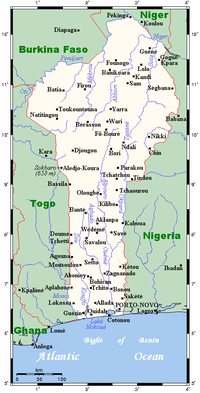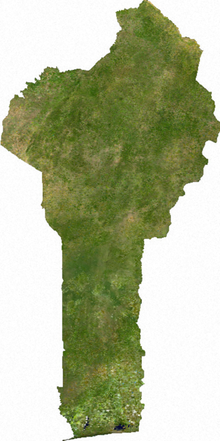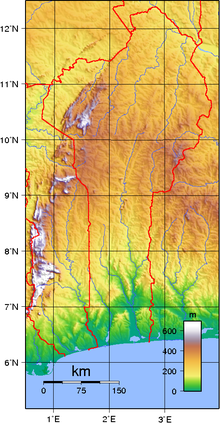- Geography of Benin
-
Benin, a narrow, key-shaped, north-south strip of land in West Africa, lies between the Equator and the Tropic of Cancer. Benin's latitude ranges from 6°30′ N to 12°30′ N and its longitude from 1° E to 3°40′ E. Benin is bounded by Togo to the west, Burkina Faso and Niger to the north, Nigeria to the east, and the Bight of Benin to the south. With an area of 112,622 square kilometers, roughly the size of Pennsylvania and slightly bigger than Bulgaria, Benin extends from the Niger River in the north to the Atlantic Ocean in the south, a distance of 700 km (435 mi). Although the coastline measures 121 km (75 mi), the country measures about 325 km (202 mi) at its widest point. It is one of the smaller countries in West Africa, about one eighth the size of Nigeria, its neighbor to the east. It is, however, twice as large as Togo, its neighbor to the west. A relief map of Benin shows that it has little variation in elevation (average elevation 200 meters).
Contents
Biogeography
The country can be divided into four main areas from the south to the north. The low-lying, sandy, coastal plain (highest elevation 10 meters) is, at most, 10 km wide. It is marshy and dotted with lakes and lagoons communicating with the ocean. The plateaus of southern Benin (altitude comprised between 20 meters and 200 meters) are split by valleys running north to south along the Couffo, Zou, and Oueme Rivers, an area that has been categorised by the World Wildlife Fund as part of the Guinean forest-savanna mosaic ecoregion. Then an area of flat lands dotted with rocky hills whose altitude seldom reaches 400 meters extends around Nikki and Save. Finally, the Atacora mountain range extends along the northwest border and into Togo with the highest point, Mont Sokbaro, at 658 meters.
Benin has fields of lying fallow, mangroves, and remnants of large sacred forests. In the rest of the country, the savanna is covered with thorny scrubs and dotted with huge baobab trees. Some forests line the banks of rivers. In the north and alice is cool i National Park]] attract tourists eager to see elephants, lions, antelopes, hippos and monkeys. Previously Benin offered habitat for the endangered Painted Hunting Dog, Lycaon pictus,[1] although this canid is considered to have been extirpated from Benin, due to human population expansion. Woodlands comprise approximately 31 percent of the land area of Benin.[2]
Location: Western Africa, bordering the North Atlantic Ocean, between Nigeria and Togo
Geographic coordinates: 9°30′N 2°15′E / 9.5°N 2.25°E
Map references: Africa
Area:
total: 112 620 km²
country comparison to the world: 108
land: 110 620 km²
water: 2 000 km²Area comparative
- Australia comparative: about half the size of Victoria
- Canada comparative: 1.5 times larger than New Brunswick
- United Kingdom comparative: smaller than England
- United States comparative: slightly smaller than Pennsylvania
Land boundaries:
total: 1 989 km
border countries: Burkina Faso 306 km, Niger 266 km, Nigeria 773 km, Togo 644 kmCoastline: 121 km
Maritime claims:
territorial sea: 200 nautical miles (370.4 km)Climate: tropical; hot, humid in south; semiarid in north
Terrain: mostly flat to undulating plain; some hills and low mountains
Elevation extremes:
lowest point: Atlantic Ocean 0 m
highest point: Mont Sokbaro 658 mNatural resources: small offshore oil deposits, limestone, marble, timber
Land use:
arable land: 23.53%
permanent crops: 2.37%
other: 74.1% (2005)Irrigated land: 120 km² (2003)
'Total renewable water resources: 25.8 cu km (2001)
Freshwater withdrawal (domestic/industrial/agricultural):
total: 0.13 cu km/yr (32%/23%/45%)
per capita: 15 cu m/yr (2001)Natural hazards: hot, dry, dusty harmattan wind may affect north in December to March
Environment - current issues: inadequate supplies of potable water; poaching threatens wildlife populations; deforestation; desertification
Environment - international agreements:
party to: Biodiversity, Climate Change, Climate Change-Kyoto Protocol Desertification, Endangered Species, Environmental Modification, Hazardous Wastes, Law of the Sea, Ozone Layer Protection, Ship Pollution, Wetlands, Whaling
signed, but not ratified: none of the selected agreementsGeography - note: sandbanks create difficult access to a coast with no natural harbors, river mouths, or islands.
Climate
Benin's climate is hot and humid. Annual rainfall in the coastal area averages 1,360 mm (53.5 in), not particularly high for coastal West Africa. Benin has two rainy and two dry seasons. The principal rainy season is from April to late July, with a shorter less intense rainy period from late September to November. The main dry season is from December to April, with a short cooler dry season from late July to early September. Temperatures and humidity are high along the tropical coast. In Cotonou, the average maximum temperature is 31 °C (87.8 °F); the minimum is 24 °C (75.2 °F). Variations in temperature increase when moving north through a savanna and plateau toward the Sahel. A dry wind from the Sahara called the harmattan blows from December to March. Grass dries up, the vegetation turns reddish brown, and a veil of fine dust hangs over the country, causing the skies to be overcast. It is also the season when farmers burn brush in the fields.
Extreme points
This is a list of the extreme points of Benin, the points that are farther north, south, east or west than any other location.
- Northernmost point – the confluence of the Mékrou river and the river Niger on the border with Niger, Alibori Department
- Easternmost point – unnamed location on the border with Nigeria immediately east of the town of Néganzi, Borgou Department
- Southernmost point – the point at which the border with Togo enters the Atlantic Ocean, Mono Department
- Westernmost point - unnamed location on the boder with Togo immediately south-wets of the town of Datori-Tiokossi, Atakora Department
References
- C. Michael Hogan. 2009. Painted Hunting Dog: Lycaon pictus, GlobalTwitcher.com, ed. N. Stromberg
- Rebecca Kormos and Christophe Boesch. 2003. West African chimpanzees: status survey and conservation action plan, International Union for Conservation of Nature and Natural Resources, IUCN/SSC Primate Specialist Group, 219 pages ISBN 2831707331, 9782831707334
 This article incorporates public domain material from websites or documents of the CIA World Factbook.
This article incorporates public domain material from websites or documents of the CIA World Factbook. This article incorporates public domain material from websites or documents of the United States Department of State (Background Notes).
This article incorporates public domain material from websites or documents of the United States Department of State (Background Notes).
Line notes
External links
- Soil Maps of Benin European Digital Archive on the Soil Maps of the world
Sovereign
states- Algeria
- Angola
- Benin
- Botswana
- Burkina Faso
- Burundi
- Cameroon
- Cape Verde
- Central African Republic
- Chad
- Comoros
- Democratic Republic of the Congo
- Republic of the Congo
- Côte d'Ivoire (Ivory Coast)
- Djibouti
- Egypt
- Equatorial Guinea
- Eritrea
- Ethiopia
- Gabon
- The Gambia
- Ghana
- Guinea
- Guinea-Bissau
- Kenya
- Lesotho
- Liberia
- Libya
- Madagascar
- Malawi
- Mali
- Mauritania
- Mauritius
- Morocco
- Mozambique
- Namibia
- Niger
- Nigeria
- Rwanda
- São Tomé and Príncipe
- Senegal
- Seychelles
- Sierra Leone
- Somalia
- South Africa
- South Sudan
- Sudan
- Swaziland
- Tanzania
- Togo
- Tunisia
- Uganda
- Zambia
- Zimbabwe
States with limited
recognition- Sahrawi Arab Democratic Republic
- Somaliland
Dependencies and
other territories- Canary Islands / Ceuta / Melilla / Plazas de soberanía (Spain)
- Madeira (Portugal)
- Mayotte / Réunion (France)
- Saint Helena / Ascension Island / Tristan da Cunha (United Kingdom)
- Western Sahara
Climate of Africa Sovereign
states- Algeria
- Angola
- Benin
- Botswana
- Burkina Faso
- Burundi
- Cameroon
- Cape Verde
- Central African Republic
- Chad
- Comoros
- Democratic Republic of the Congo
- Republic of the Congo
- Côte d'Ivoire (Ivory Coast)
- Djibouti
- Egypt
- Equatorial Guinea
- Eritrea
- Ethiopia
- Gabon
- The Gambia
- Ghana
- Guinea
- Guinea-Bissau
- Kenya
- Lesotho
- Liberia
- Libya
- Madagascar
- Malawi
- Mali
- Mauritania
- Mauritius
- Morocco
- Mozambique
- Namibia
- Niger
- Nigeria
- Rwanda
- São Tomé and Príncipe
- Senegal
- Seychelles
- Sierra Leone
- Somalia
- South Africa
- South Sudan
- Sudan
- Swaziland
- Tanzania
- Togo
- Tunisia
- Uganda
- Zambia
- Zimbabwe
States with limited
recognition- Sahrawi Arab Democratic Republic
- Somaliland
Dependencies and
other territories- Canary Islands / Ceuta / Melilla / Plazas de soberanía (Spain)
- Madeira (Portugal)
- Mayotte / Réunion (France)
- Saint Helena / Ascension Island / Tristan da Cunha (United Kingdom)
- Western Sahara
Categories:
Wikimedia Foundation. 2010.



